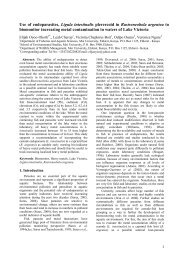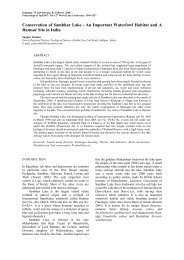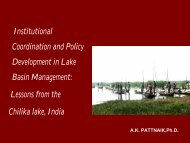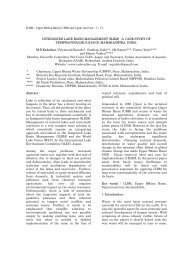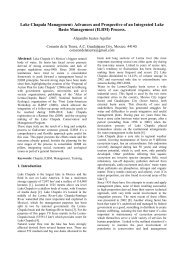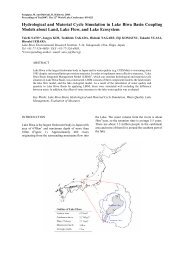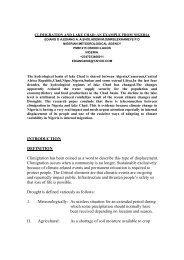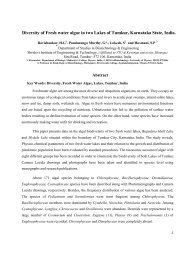Management of Haors, Baors, and Beels in Bangladesh Lessons for ...
Management of Haors, Baors, and Beels in Bangladesh Lessons for ...
Management of Haors, Baors, and Beels in Bangladesh Lessons for ...
Create successful ePaper yourself
Turn your PDF publications into a flip-book with our unique Google optimized e-Paper software.
Annex 1<br />
Participatory Action Plan Development (PAPD)<br />
PAPD is a methodology <strong>for</strong> build<strong>in</strong>g consensus among<br />
multiple stakeholder groups on<br />
the susta<strong>in</strong>able management <strong>of</strong> Figure 3. The PAPD method<br />
natural resources. PAPD uses<br />
different participatory tools<br />
to reach consensus among the<br />
community on actions that are<br />
needed to improve the management<br />
<strong>of</strong> natural resource. PAPD<br />
recognizes the many stakeholders<br />
<strong>in</strong>volved <strong>in</strong> the management<br />
<strong>and</strong> use <strong>of</strong> natural resources <strong>and</strong><br />
ensure that all stakeholders’<br />
views are represented. PAPD<br />
encourages community participants<br />
to respect others’ concerns<br />
<strong>and</strong> to appreciate:<br />
• their dependency on the<br />
natural resource base<br />
• the function <strong>and</strong> values <strong>of</strong><br />
natural resource system<br />
PAPD is a dynamic method, but<br />
there are no immediate solutions.<br />
A cont<strong>in</strong>uous process <strong>of</strong><br />
action <strong>and</strong> reflection is needed<br />
to further develop community<br />
action plans as livelihoods<br />
<strong>and</strong> the natural resource base<br />
changes.<br />
The PAPD methodology was<br />
developed by CNRS <strong>in</strong> 1997<br />
to build consensus among<br />
stakeholders <strong>in</strong> floodpla<strong>in</strong><br />
resources management <strong>in</strong><br />
Charan Beel, Kalihati, Tangail<br />
district (Funded by the UK’s<br />
Department <strong>for</strong> International<br />
Development DFID, Natural<br />
Resource System Programme<br />
Project R6756). CNRS acknowledges<br />
In<strong>for</strong>mation, Tra<strong>in</strong><strong>in</strong>g<br />
<strong>and</strong> Development Ltd (ITAD)<br />
<strong>for</strong> the development <strong>of</strong> PAPD.<br />
In <strong>Bangladesh</strong> PAPD have been<br />
used by number <strong>of</strong> organizations<br />
<strong>in</strong>clud<strong>in</strong>g, <strong>Bangladesh</strong><br />
Center <strong>for</strong> Advanced Studies,<br />
<strong>Bangladesh</strong> POUSH, Center<br />
<strong>for</strong> Susta<strong>in</strong>able Development,<br />
WorldFish Center, Intermediate<br />
Figure 4. PAPD Activity Flow Chart<br />
Technology Development Group (ITDG <strong>Bangladesh</strong>),<br />
IUCN <strong>Bangladesh</strong>, Department <strong>of</strong> Fisheries <strong>of</strong> Government<br />
<strong>of</strong> <strong>Bangladesh</strong>, <strong>for</strong> successful management <strong>of</strong> wetl<strong>and</strong>s.<br />
10 <strong>Management</strong> <strong>of</strong> <strong>Haors</strong>, <strong>Baors</strong>, <strong>and</strong> <strong>Beels</strong> <strong>in</strong> <strong>Bangladesh</strong>



